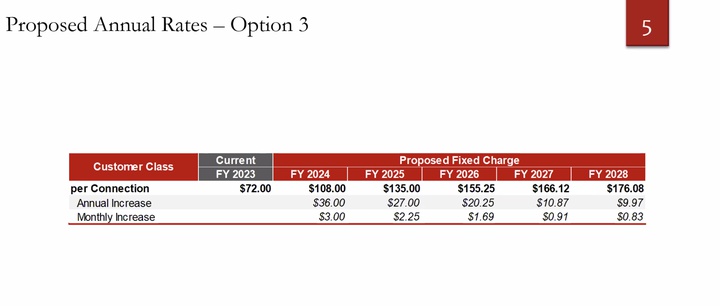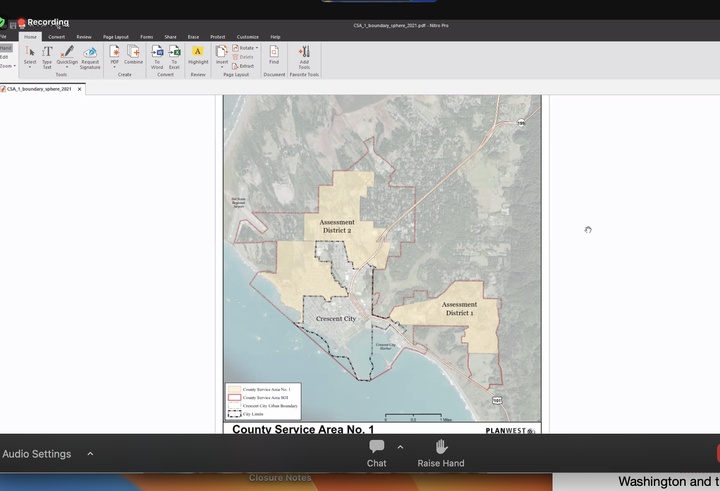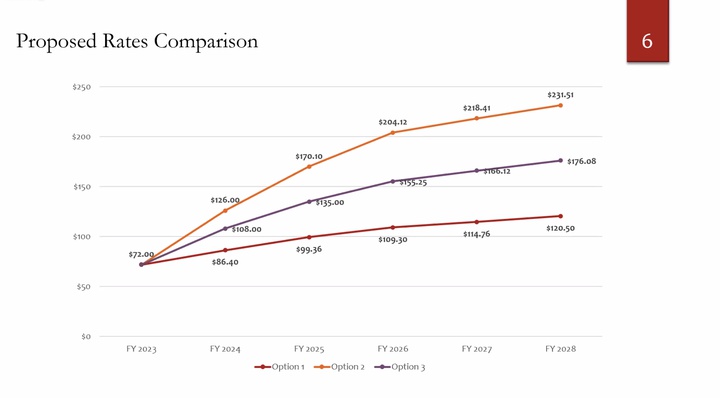Jessica Cejnar Andrews / Tuesday, April 25, 2023 @ 3:47 p.m. / Infrastructure, Local Government
Sewer Rate Increase May Be In the Pipeline For 3,300 Del Norte County Customers; Supervisors Ask About Consolidation Process

This proposed sewer rate increase option is a compromise of sorts between a model that's more "bare bones" and another option that would have seen more of a rate increase. | Screenshot
Document:
###
Del Norte County supervisors favored a proposed middle ground that could lead to the first sewer rate increase customers in the County Service Area have seen since about 1981.
Under the third of three proposed options, annual sewer bills for 3,300 property owners in the CSA-1 service area, which includes the Bertsch-Oceanview and Elk Valley Road areas outside Crescent City limits, would increase annually for the next five years.
Starting from the current $72 rate, property owners would pay $108 annually in fiscal year 2024; $135 in fiscal year 2025; $155.25 in fiscal year 2026; $166.12 in fiscal year 2027; and, finally, $176.08 per year by 2028.
These rates are included with the property taxes homeowners and business owners in the assessment district pay each year, County Engineer Jon Olson said.
The proposed rate increase is necessary to avoid a deficit in the CSA’s operating and maintenance budget, Olson told supervisors.
But of the three options, while the choice the Board of Supervisors made Tuesday was better than the “bare bones,” it won’t accomplish the county’s goals as quickly as Option 2.
“In the long run it doesn’t accomplish our goals as quickly,” Olson said, estimating that conducting an assessment of the underground sewer lines within the County Service Area would cost about $800,000. “(We’re) now looking at five to six years before we have the funding set aside to do a condition assessment. I like to save up cash and pay for it — that’s just a personal philosophy — but I totally understand debt service and trying to accomplish our goals sooner.”

The county's proposed sewer rate increase applies to 3,300 customers living within its CSA-1 area. | Screenshot
The Board of Supervisors’ approval on Tuesday starts the Proposition 218 process, giving property owners in CSA-1 the opportunity to protest the proposed rate increase. If 50 percent-plus-1 submit a valid protest, the rate increase would die, said Zachary Van Dinther, an economist at Robert D. Niehaus, a Santa Barbara-based economic consulting firm the county hired to conduct a sewer rate study.
The county will notify property owners by mail of the proposed rate increase. Forty-five days after those notifications are distributed, property owners will have an opportunity to protest at a public hearing.
Currently, with 3,300 connections, customers’ annual rate of $72 generates about $240,000, which for this fiscal year is just enough to meet the county’s operating and maintenance expenses, Van Dinther said. The goal for all three options is to create a reserve balance of $550,000 by fiscal year 2028, he said.
The first option would have increased customers’ bills cumulatively by about $4 per month over five years, Van Dinther said..
Under that first option, there wouldn’t be any planned rate-funded capital projects within the CSA. The rate increase would contribute to an operating reserve of $150,000, which would pay for about six months of the system’s operating expenses. The county would also set aside $80,000 in a capital improvement project reserve.
The second of three options would have meant a $13 cumulative monthly increase over five years to customers’ sewer bills, Van Dinther said.
It would have included $250,000 in rate-funded capital expenditures, Van Dinther said.
“This funding is intended to complete some needed projects within the service area,” he said.
The third option would provide $125,000 in rate-funded capital improvement dollars through fiscal year 2028, Van Dinther said.
The economist didn’t include that third option in the presentation he gave to the Board, bringing it up when District 2 Supervisor Valerie Starkey asked him if he had a compromise.
“We had an Option 3 in case it was necessary,” Van Dinther told supervisors. “This looks to find a middle ground between Option 1 and Option 2.”

A comparison of Del Norte County's proposed rate increases.
According to Olson, the county’s largest operating expense for its CSA is electricity. He said it’s about $30,000-$45,000 a year depending on how rainy it is.
The proposed rate increase prompted District 4 Supervisor Joey Borges to ask Olson why the county is involved in the sewer system in the first place.
According to Olson, for the past 10 years, the Local Agency Formation Commission recommended consolidation for the CSA and a handful of local water districts. Though the proposed rate increase applies to customers living within the CSA-1 area, which includes the Bertsch Tract, the county also operates the wastewater collection system outside city limits along Northcrest Drive and Pebble Beach Drive.
“Ideally the recommendation from LAFCO is that the city would take over those CSAs, or water districts, and I’ll focus it toward the sewer system,” he said. “What was recommended is both of those areas, although they all fall under our jurisdiction currently, those would be turned over to the city and the city would take ownership and operation and maintenance. They’re already doing the operation and maintenance, it’s just a matter of us collecting money and passing it through to the city to pay for it and whatever grants we go after to pay for capital improvements.”
According to Olson, Crescent City’s former public works director, there’s resistance at the city to that long-term solution.
“If you’re going to take on a system, it’s great if it’s brand new, but our system is not brand new,” he said. “Maybe I would take it if you gave me that plus $100 million or something like that.”
Consolidating those water districts and the County Service Area would make more sense for the community and there are grants available to help with that endeavor, Olson told supervisors.
Meanwhile, District 3 Supervisor Chris Howard suggested that going through the Prop 218 process should be a last resort. He broached the option of using Measure R sales tax revenue to help soften the blow for those property owners in CSA-1.
Olson said that could work, but it might also draw complaints from taxpayers who don’t live within the CSA.
County Counsel Joel Campbell-Blair said the Board of Supervisors can approve a loan of general fund dollars to the CSA and can forgive that loan. But they’d have to make that loan annually by 4-5ths vote and then vote to forgive it.
“You wouldn’t want your general taxpayers to have money going in there that they don’t have any say over,” he said.
District 5 Supervisor Dean Wilson, whose district includes the CSA-1 area, said the compromise might be an easier pill to swallow for his constituents.
“These are not affluent areas,” he said. “Option 3 is much easier to absorb and more likely to pass than Option 2.”
CLICK TO MANAGE